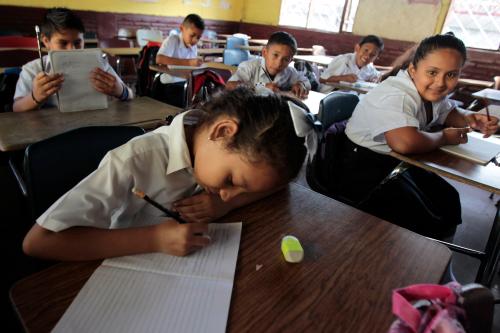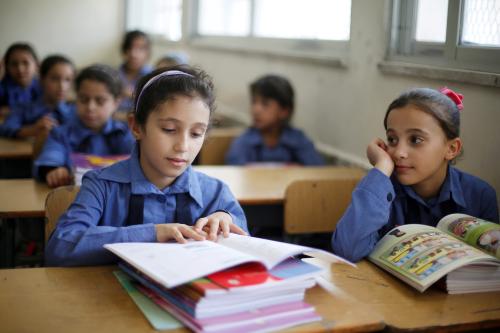This is the second post in a series about using data from 21st century skills assessments.
The Australian Council for Educational Research (ACER) has participated in the debate about the use of assessment data in education for many years. The Brookings report “Use of data from 21st century skills assessments: Issues and key principles” helps shape a reform agenda that ACER also seeks to promote. Research on the definition and description of skills deemed essential for citizens and employees, greater emphasis on reconceptualizing existing curriculum domains, and capacity building work through initiatives such as the Brookings-led Optimizing Assessment for All project will inform the feasibility of using a data-driven approach to assessment development within and across countries, as well as investigating the generalizability of 21st century skills across subject areas and locations.
However, to teach and assess these skills we need to know more about them. To do this, we need data. The data may come in the form of teacher observations, or highly sophisticated process data, which can help us understand how the skills manifest, what they look like, and how they typically develop. Then we can design assessments to capture evidence of the skills and their growth.
ACER’s research, through the Centre for Assessment Reform and Innovation, is helping to advance the definition of some of these skills and to better understand how these skills develop, in order to support the generation of better, more reliable classroom-based assessments. One of the main uses of assessment data is to inform the development of empirically-grounded learning progressions. Learning progressions can benefit the general understanding of 21st century skills, thereby playing an important role in improving the feedback loop of teaching, learning, and assessing these skills. As such, the research is focused on development of a suite of resources based upon learning progressions for skills including critical thinking, collaboration, and creative thinking. The Brookings report has shown that countries are beginning to include learning progressions (or the concept of progress) in their policy documents, and not just in core domains, but also in 21st century skills. More countries should follow suit as the benefits of learning progressions in monitoring student progress becomes clearer and capacity towards developing learning progressions becomes more widespread.
Developing learning progressions involves defining and conceptualizing the skills from a monitoring growth perspective, based in both theoretical and empirical work. The demand for understanding the growth of skills presents a perfect example where a general approach to monitoring growth, rather than the acquisition of skill, can be applied. It is not enough to understand whether a student can solve problems, collaborate, and think critically—we need to understand what various levels of proficiency in these skills look like. And teachers then need to understand how and when their students acquired these higher levels of proficiency, so they can provide equitable opportunities to learn such skills to all students. Further, teachers need the evidence behind our understanding of skills proficiency. For example, what does a highly proficient collaborator look like? What does someone who thinks critically look like? We need examples where we can see students using their proficiencies in these skills, such as how their subject knowledge or ability to learn and adapt improved. Essentially, we need road maps to understand the nature and growth of these skills.
A prototype of this approach is being tested in Australia, and it will be essential to contextualize the assessment resources to the local environment. In Australia, this involves linking resources to the Australian Curriculum, Assessment, and Reporting Authority’s (ACARA) General Capabilities, Australia’s equivalent of 21st century skills.
The more familiar educators are with the skills and their varying levels of proficiency, the more readily they will be able to recognize them in the classroom. Video and work examples of how proficient students look in relation to constructs such as critical thinking, creative thinking, and collaboration will help educators interpret the data collected. Along with a common understanding of skills, a common language to describe them is needed so that teachers can share observations with students, parents, and other educators. For example, the current ACER assessments of general capabilities treat feedback to students and parents as useful for nurturing and developing skills. Additionally, student performance in online assessment tasks can provide teachers with useful data to teach and assess the skills. Using the data from the tools, educators can gauge a student’s level of growth in each of the skills assessed. Once they have established a student’s level of proficiency, they can then identify what aspect of the skills need to be further developed and target ongoing interventions. Overall, the intention is to provide a clear framework for implementation, presenting teachers with data that can otherwise be difficult to get and establish a common language to discuss the skills. Central to this effort will be generating sufficient evidence to validate an approach that works.
Orienting assessment resources to local country contexts is an important step in the process. The resources need to fit the purpose, curriculum intentions, and policies locally, and each country will adapt their approaches to its own context. From a global perspective, though, it would be interesting to investigate the commonalities that drive success among the various country approaches.






Commentary
The use of 21st century skills assessment data: National and global perspectives
December 13, 2018